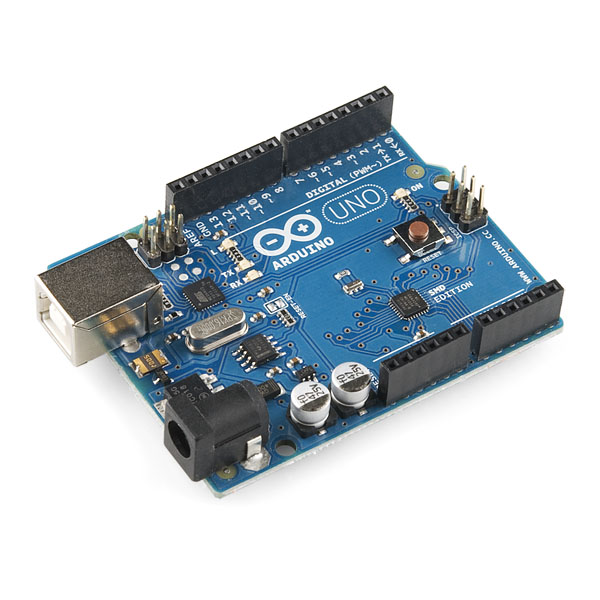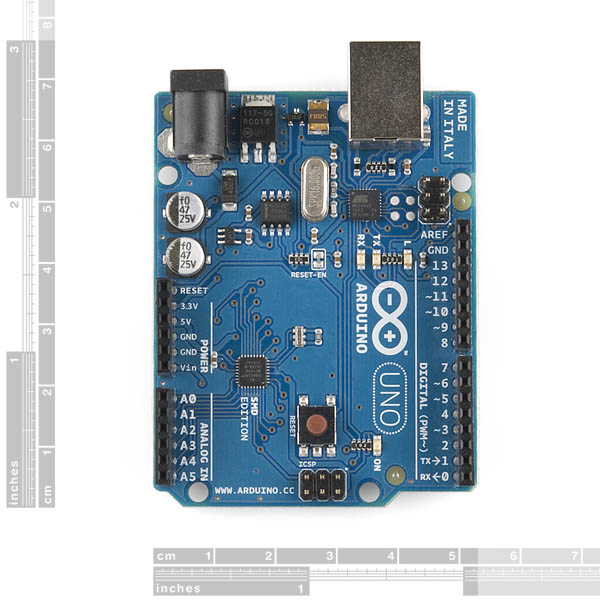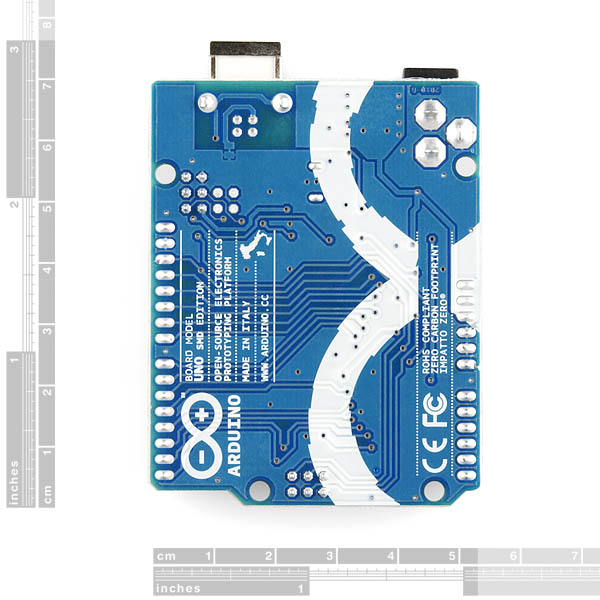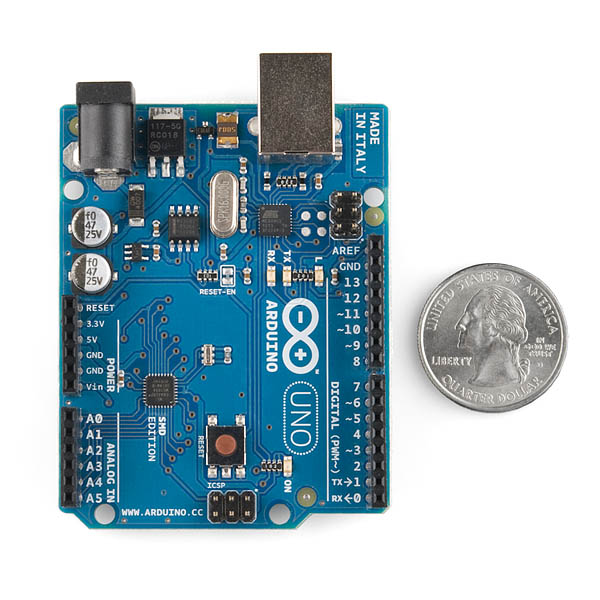Arduino Uno SMD
Replacement:DEV-11224. The R3s are here! This page is for reference only.
Arduino is an open-source physical computing platform based on a simple i/o board and a development environment that implements the Processing/Wiring language. Arduino can be used to develop stand-alone interactive objects or can be connected to software on your computer (e.g. Flash, Processing, MaxMSP). The open-source IDE can be downloaded for free (currently for Mac OS X, Windows, and Linux).
This is the new Arduino Uno. In addition to all the features of the previous board, the Uno now uses an ATmega8U2 instead of the FTDI chip. This allows for faster transfer rates, no drivers needed for Linux or Mac (inf file for Windows is needed), and the ability to have the Uno show up as a keyboard, mouse, joystick, etc.
Special SMD Version: Because Atmel is moving more and more of their production capacity to surface mount ICs, the DIP packaged ATmega328 is becoming more and more difficult to get. To keep up with demand, we now offer the Arduino Uno with an SMD ATmega328. The board is identical to the PTH version of the Uno, but you won't be able to remove the ATmega328 without some hot-air. This change shouldn't affect most users. Besides - when was the last time you managed to destroy an ATmega328 and needed to repair an Arduino board? Those things are nearly indestructible.
Not sure which Arduino or Arduino-compatible board is right for you? Check out our Arduino Buying Guide! Note: Our first batch of the Arduino SMD boards have a problem with the bootloader. If you are having trouble with your board, please contact techsupport@sparkfun.com. So just let us know if you have an issue and we'll correct it!
- ATmega328 microcontroller
- Input voltage - 7-12V
- 14 Digital I/O Pins (6 PWM outputs)
- 6 Analog Inputs
- 32k Flash Memory
- 16Mhz Clock Speed
Comments
Looking for answers to technical questions?
We welcome your comments and suggestions below. However, if you are looking for solutions to technical questions please see our Technical Assistance page.
Customer Reviews
No reviews yet.





SMD ATmega328 to DIP adapter board? That way you can still easily replace the chip but not have to find the DIP version.
Yes, this. I'd pay an extra $5 for the daughter board and adapters. Plus, it would help miniaturize standalone arduino projects even more!
What a pity ADC6 and ADC7 appear to be unconnected.
That thru-hole USB "B" connector is starting to look pretty huge to me!
This probably has an obvious answer that I've missed somewhere but, I'm guessing it doesn't come with a USB A-B cable , am I right, and can it be powered from that USB cable?
Is there a FPGA Shield (Altera, not Xilinx) for the Uno? Would LOVE one of these!
Also, is there any way to interface the Uno with MATLAB, or is the only current way available requiring compiling the MATLAB code into C code using MathWork's proprietary software, Coder? Any ideas?
There is another way to link between MATLAB and an Arduino skipping the C route. Check out the first link for a general overview of MATLAB's capabilities in this area. You will be able to code MATLAB to drive motors, control I/O, etc., all without touching C if you do not want to. You will need the support package in the second link, but with both of those, you should be set.
http://www.mathworks.com/hardware-support/arduino-matlab.html http://www.mathworks.com/matlabcentral/fileexchange/32374
Newbie question: How do I make this show up as a keyboard?
Thanks in advance!
This thing works GREAT! It worked first time right out of the box. The only thing I had to do was install the driver on my laptop (learn on this page: http://arduino.cc/en/Guide/Windows#toc4). I bought this board after repeated failure to get the 'ATmega328 w/ bootloader' (sku: DEV-09217) to work. I was using the 'Pocket AVR Programmer' (sku: PGM-09825) through USB on my laptop, but the laptop would never properly identify the programmer. I could upload the bootloader, but never upload any program. I've had no problems with the UNO board so far.
I think I'm going to try and use the Arduino Uno as an ISP programmer next; see if I can properly upload a program to that AVR chip :)
Will you post Eagle files for this device?
In a few years the arduino will be so small, yet the footprint will need to stay the same for shields... Already there is a huge chunk of open PCB real estate.
What are exact physical dimensions for Uno boards?
Thanks
Here you go.
I drew it myself using a pair of calipers for measurements.
I bought several of these the first time they were available, and won't again. They all had strange issues with Win7: Com wouldn't show up or would give an error when uploading. You would have to restart the computer start arduino fresh for it to upload,, which is a nonworkable pain. Fine with a mac ,but doesn't like windows. Anyone else have this issue?
Not a fan of SMD design.
Fried 1 Arduino last year when 12V from a motor shield sipped into the logic channel of the Arduino. $4 for a replacement Atmega chip and I was back in action. Now I keep a supply of spare microcontrollers.
Most of the time what fries is the CPU and replacing it is a lot cheaper than getting a new board.
In addition, if you plan on miniaturizing projects, you can always pull Atmega right off the duemilenove/uno and embed it into the PCB. Not an easy thing to do with surface-mount chips.
Get this for finalized designs (initially assembled and tested on Atmega boards with replaceable chips).
Any idea when these are coming back into stock? They are sold out everywhere.
976 in stock
when the F are these coming back in stock?
Any news on when you'll have more of these?
Wow, those are sold like hot bread :P
Lame - you release the SMD Arduino, but did not breakout the other 2 analog input pins. Why?
We don't make these, Arduino does.
I just got my first Arduino Uno and a microSD shield. It looks like there is interference when you nest the SD shield on the Uno. The shield hits the power and USB connectors. Does one just not push the stackable headers in all the way or is there something wrong?
If you've used our stackable headers, it should not hit. They raise the board up enough not to hit the USB and power.
I'm talking about just the Uno with the headers as installed. If you place a straight edge on the header, one can see that the ruler interferes with the connectors. You can see how one person dealt with it here (they just didn't seat the pins in the header completely):
http://blog.makezine.com/archive/2008/11/new-arduino-ethernet-shie.html?CMP=OTC-0D6B48984890
But I don't see that condition on all the pictures I see.
Just wondering if I'm missing something - not seating completely doesn't seem objectionable.
Thanks for your help!
There is just some confusion going on here. The arduino comes with 'normal' female headers installed. What RobertC is talking about is the headers you put on the ethernet shield. The SparkFun 'Stackable Headers' have very long male pins, so what you see in that picture you posted is fully seated - the male pins are just longer than the female sockets
But what you point out is still a risk. I usually place a square of electrical or kapton tape on top of the USB socket just in case.
I'm not following you. If you use the stackable headers we sell, there's no issue.
Quote: when was the last time you managed to destroy an ATmega328 and needed to repair an Arduino board?
-sparkfun
my answer: about half a project ago
No more Arduino Unos?? SFE, what have you done?!
when??? when will they come??
BAARRGGGG I need it for the instructables contest!
Hm. I just got some Arduino UNO's from sparkfun. Two as part of kits and just one by itself.
Two of these (one in a kit, and the one by itself) are the SMD variant UNO.
To be clear: The SparkFun starter's kit came with the non-SMD UNO. The inventor's kit came with an SMD version UNO, and I bought a third UNO that was also the SMD variant.
Now, when I program the SMD variant one and the non-SMD variant one (via the Arduino app for OS X, on a mac obviously) the program runs fine.
However, with the SMD ones, if I remove power and then power it up again, the program is gone, or not running. It just goes back to the boot loader blinking the LED on pin 13.
However with the NON-SMD one, I program it, I remove power, I put power back.. and the program is running like it should be.
Am I missing something totally obvious? Nothing anywhere seems to refer to this difference in behavior, yet both of the SMD ones are showing this and the non-SMD one is working as all the documentation seems to suggest?
An Arduino that does not run its program after being reset or powered up is not very useful.
This is from the Arduino Website-- last year I fried a Duemilanove and I used this to fix the bootloader...
http://www.arduino.cc/en/Hacking/ParallelProgrammer
Just in case tech support is listening, I'm having the same problem. I can sometimes get it to boot properly by holding reset and applying power at the same time, but that's not a solution. Just purchased this last week and so far can't get past a basic test program.
Apparently there are a batch of bad Uno SMD edition Arduino's out there. Here is what tech support has told me:
I got one of these cards too...
Very disapointing as this is my first try in AVR world :(, this board is just useless to me.
Any idea of how to "repair" these ?
Saddly you can't bitbang these easy.
if you are confortable with soldering you can try get a avr programer such as the USBtinyISP from Adafruit or get one from sparkfun such as the STK500 USB Programmer and use the arduino IDE to reprogram Bootloader
Okay, doing more investigating it seems that this is a known problem with some Arduino's that are not the original non-SMD version:
http://code.google.com/p/optiboot/issues/detail?id=7
I am wondering what version of the optiboot boot loader actually works and then see if I can somehow reprogram the bootloader on the SMD Uno's I have.
For what it is worth I see references on the arduino.cc forums to some people having problems with some versions of the optiboot boat loader causing "flash amnesia." That seems to be exactly what I am seeing with the two SMD variant UNO's I have.
Being as these are UNO's I have no easy way to reflash the boot loader, at least not until I order some more parts. B-(
I also think a removable SMD adapter would be better.
Seriously, this should basically be the size of the Pro Mini or perhaps a USB Dongle. And of course, they can provide or sell adapters to use existing shields. Let's just all remember that the Uno is entended to be for development. We are expected to DIY the final product rather than use a bunch of Uno's.
IF Arduino wants to move into the current era, then they could redesign everything to be more like this... http://karuppuswamy.com/wordpress/wp-content/uploads/2010/10/ez430-f2013-450x281.jpg
The MCU board is tiny and removable, just add 3V3. I use the ez430 on a breadboard as well. The MCU itself isn't direct competition to Arduino's for various reasons... but there is plenty of room on the other side of that miniMCU board to add a few more features. Suprising what you can fit into 2K of memory!
Anyway... I definitely second/third the suggestions to remove the oversized USB & Power connectors and while we are at it, maybe fix those gaps in the headers... but maybe we should be telling Arduino and not sparkfun.
What type of cable do you use for this Arduino?
USB A to B cable
Cool!
Do you have any plan to develop 3.3 V Uno?
Now, without looking at the data sheets, I dont see why they don't have a similar chip as the USB-serial for the main CPU, the USB host would be very useful... (come on extra hot key buttons)
It's less convenient; you can't have a single board with different mega328, to swap out the chip for different project. Or if your mega328 dies, (which is the most likely problem with arduinos) then you can't replace it easily.
Seems like this is a downgrade from the dip version, and should be at least cheaper than the original dip version.
Its not an upgrade or downgrade. Its just different.
DIP ATMega is one of the main reasons I love the arduino, it can double as a programmer... I'm not sure how I feel about this... Every arduino update recently has made it harder and harder to DIYuino...
Besides - when was the last time you managed to destroy an ATmega328 and needed to repair an Arduino board?
heh. march.
may.
Kids, don't put 12v where there should be 5v - it'll mess up more than your ATmega328. ;)
Agreed. Fried an Ethernet shield as well as my ATMEGA doing that...
And, November...
April. And, the the overload went thru to a big board full of reed relays, fried 'em all. Again: if the hole says '5 vdc' on it, don't shove the cable marked '12 vdc' in it. ;-(
January(2011), when you are driving motors, use H-Bridge :)
2 seconds ago
Few months ago, lost duemilanove to a lightning strike (power surge). Last week - Arduino Uno got dropped across the terminals of a high-voltage cap bank, which then discharged. Had to beat the melted remnants of the arduino off the bus bars with a hammer.
It appears that, on the *8u2, pins 18 - 21 are broken out to solder pads.
Am I seeing this correctly? (I sure hope so.)
I believe these were used to program the 8u2.
That's what the other 6pin header is for.
Looks like it to me! But what's on the opposite side? It looks like more test pads, but I don't see traces going to them, or vias from the top. Weird.
Eagle files would be nice.
Arduino should ditch the large USB and power connectors.
Time for Arduino Duo? Duemillaonze? Arduinew?
I like those names. How about the "SparkDuino"?
how about "Arduino Plus", an arduino with a color LCD to the right of the ISP header.
You can't change the board shape, as there are many shields that rely on this shape. If size is an issue, sparkfun offers other arduinos that are much smaller.
I agree they need to redesign the board though. Those screw holes are too close to other stuff. Perhaps they could use a smaller USB socket, but it's not a big deal.
Of course the board can be changed in many ways and I think a smaller "core" board is needed. It would provide the shield vendors with an opportunity to sell an "adapter" board to take your original shield to the Version 2.0 standard also.
If we're talking design improvements then I might go so far as to suggest that with the Uno's fancy new mega8u2 (the chip near the USB port) serving USB duty, they could ditch the classic bootloader and provide firmware-flashing over ISP instead (then either the UART or SPI could be used for host/Arduino communication, allowing higher speeds.)
The long-term objective should be for the mega8u2 to drive debugWire on the main chip directly, but unlike ARM and TI, Atmel have not published their dW protocol spec so that unfortunately isn't possible today.
I'm sure the Arduino team have already considered these ideas, but one can dream, right?
While we are redesigning the board shape, can we get the headers aligned on a standard 0.1" grid? That way any pad-per-hole type perf board can be used as a prototyping shield. I'm all for asymmetrical layout so shields can't be plugged in backwards, but that 0.15" gap between D7 and D8 just seems unnecessary.
You can always use Offset Headers.
Exactly. It really doesn't make much sense to have built in USB functionality unless you are going to keep it connected to a computer.
The board size could be decreased a bit.